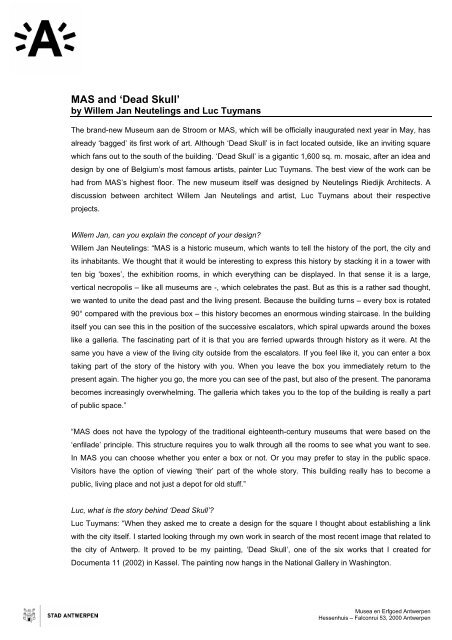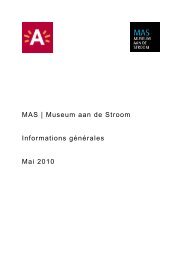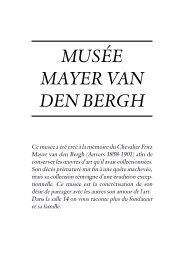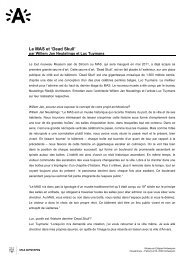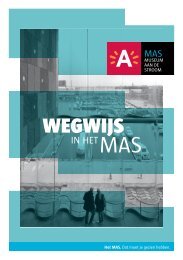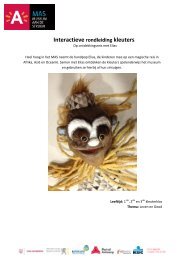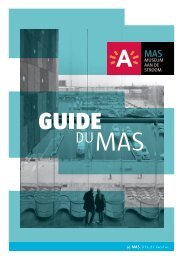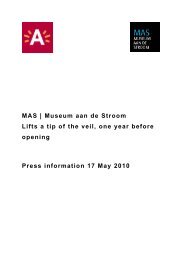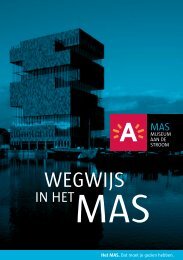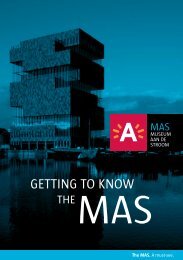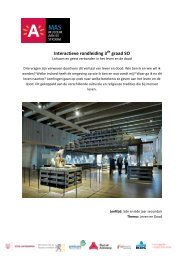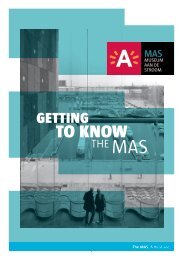MAS and 'Dead Skull' - Museum aan de Stroom
MAS and 'Dead Skull' - Museum aan de Stroom
MAS and 'Dead Skull' - Museum aan de Stroom
You also want an ePaper? Increase the reach of your titles
YUMPU automatically turns print PDFs into web optimized ePapers that Google loves.
<strong>MAS</strong> <strong>and</strong> ‘Dead Skull’by Willem Jan Neutelings <strong>and</strong> Luc TuymansThe br<strong>and</strong>-new <strong>Museum</strong> <strong>aan</strong> <strong>de</strong> <strong>Stroom</strong> or <strong>MAS</strong>, which will be officially inaugurated next year in May, hasalready ‘bagged’ its first work of art. Although ‘Dead Skull’ is in fact located outsi<strong>de</strong>, like an inviting squarewhich fans out to the south of the building. ‘Dead Skull’ is a gigantic 1,600 sq. m. mosaic, after an i<strong>de</strong>a <strong>and</strong><strong>de</strong>sign by one of Belgium’s most famous artists, painter Luc Tuymans. The best view of the work can behad from <strong>MAS</strong>’s highest floor. The new museum itself was <strong>de</strong>signed by Neutelings Riedijk Architects. Adiscussion between architect Willem Jan Neutelings <strong>and</strong> artist, Luc Tuymans about their respectiveprojects.Willem Jan, can you explain the concept of your <strong>de</strong>sign?Willem Jan Neutelings: “<strong>MAS</strong> is a historic museum, which wants to tell the history of the port, the city <strong>and</strong>its inhabitants. We thought that it would be interesting to express this history by stacking it in a tower withten big ‘boxes’, the exhibition rooms, in which everything can be displayed. In that sense it is a large,vertical necropolis – like all museums are -, which celebrates the past. But as this is a rather sad thought,we wanted to unite the <strong>de</strong>ad past <strong>and</strong> the living present. Because the building turns – every box is rotated90° compared with the previous box – this history becomes an enormous winding staircase. In the buildingitself you can see this in the position of the successive escalators, which spiral upwards around the boxeslike a galleria. The fascinating part of it is that you are ferried upwards through history as it were. At thesame you have a view of the living city outsi<strong>de</strong> from the escalators. If you feel like it, you can enter a boxtaking part of the story of the history with you. When you leave the box you immediately return to thepresent again. The higher you go, the more you can see of the past, but also of the present. The panoramabecomes increasingly overwhelming. The galleria which takes you to the top of the building is really a partof public space.”“<strong>MAS</strong> does not have the typology of the traditional eighteenth-century museums that were based on the‘enfila<strong>de</strong>’ principle. This structure requires you to walk through all the rooms to see what you want to see.In <strong>MAS</strong> you can choose whether you enter a box or not. Or you may prefer to stay in the public space.Visitors have the option of viewing ‘their’ part of the whole story. This building really has to become apublic, living place <strong>and</strong> not just a <strong>de</strong>pot for old stuff.”Luc, what is the story behind ‘Dead Skull’?Luc Tuymans: “When they asked me to create a <strong>de</strong>sign for the square I thought about establishing a linkwith the city itself. I started looking through my own work in search of the most recent image that related tothe city of Antwerp. It proved to be my painting, ‘Dead Skull’, one of the six works that I created forDocumenta 11 (2002) in Kassel. The painting now hangs in the National Gallery in Washington.Musea en Erfgoed AntwerpenHessenhuis – Falconrui 53, 2000 Antwerpen
This painting directly draws on the plaque for the painter Quentin Matsys, which has been appen<strong>de</strong>d to thesi<strong>de</strong> of Antwerp’s cathedral. When I started painting this canvas, I first ma<strong>de</strong> a Polaroid of the plaque. It<strong>de</strong>picts a skull with heraldic symbols. Because the southern faça<strong>de</strong> of the <strong>MAS</strong> building refers to the city Iwanted to create a link with the city with this image. It has been blown up consi<strong>de</strong>rably into a 1,600 sq.m.square <strong>and</strong> is ma<strong>de</strong> entirely of granite, with eleven colours. The granite has been sourced from all over theworld <strong>and</strong> because these eleven colours did not allow for sufficient nuance we also <strong>de</strong>ci<strong>de</strong>d to work withsmaller <strong>and</strong> bigger stones. With the help of a computer specialist <strong>and</strong> an architect we <strong>de</strong>signed a layingpattern in or<strong>de</strong>r to be able to represent all the nuances. I think we succee<strong>de</strong>d. Because we used granitethe work is frost <strong>and</strong> rain-resistant <strong>and</strong> will also withst<strong>and</strong> any possible uses by the public. This would havebeen impossible with composition stone, because it is too fragile.”“The content of this work is also relevant: the skull helps to symbolically calibrate the work, it is a vanitasmotif <strong>and</strong> a sign of mortality, with several art historical references which have been <strong>de</strong>veloped by severalgreat masters. Just think of Hans Holbein’s famous canvas, ‘The Ambassadors’. And finally there is themyth of Quentin Matsys, who was one of the foun<strong>de</strong>rs of the Antwerp school. There is a famous storyabout him: Matsys was a smith <strong>and</strong> wanted to marry the daughter of a master painter. But this wasimpossible due to the fact that they came from different social classes. So Matsys broke into the painter’sstudio <strong>and</strong> like a virtuoso painted a fly on the back of the horse which the master was painting. When thepainter returned home <strong>and</strong> wanted to continue painting, he tried to swat the fly away. It was only when herealized that the fly was not real that he granted Matsys permission to marry his daughter. A more sinisterstory has it that Matsys committed suici<strong>de</strong> which is why the plaque had to be placed outsi<strong>de</strong> the cathedralinstead of insi<strong>de</strong>.”“We created something completely new: this type of mosaic has never been done. Just like it is not evi<strong>de</strong>ntto translate a painted image in stone. And the red colour of the building highlights the image even more.You will see this even more once the mosaic has really dried in six months from now <strong>and</strong> every nuancebecomes visible. And it also invites visitors to walk through the museum’s galleria which Willem Jan wasreferring to: you can only see the whole work from the restaurant on the top floor. At the same time, theimage on the ground floor level becomes a real square, in which people can function.”Willem Jan, you once <strong>de</strong>scribed this museum as a milkmaid.Neutelings: “I was talking about the building’s construction. We started with a concrete middle core, towhich we appen<strong>de</strong>d all these ‘boxes’. There is not a single column. So it is quite similar to the yoke on theshoul<strong>de</strong>rs of a milkmaid from which the pails are suspen<strong>de</strong>d: just like the full pails keep the milkmaid inbalance, the boxes level the building. We worked with cantilevers instead of with columns: it is a thrilling,intense way of keeping everything in balance. Because there were no columns we were able to filleverything up with glass, which contributes to the building’s amazing appearance at night: the buildingturns itself insi<strong>de</strong> out as it were, because the boxes become black <strong>and</strong> the transparent parts light up.”Musea en Erfgoed AntwerpenHessenhuis – Falconrui 53, 2000 Antwerpen
The glass is essential.Neutelings: “This is a museum without daylight, at least as far as the boxes are concerned. We thoughtabout this quite a bit, but the fact that there will be a lot of old objects on display here which cannot tolerateany daylight un<strong>de</strong>rscored our choice in favour of this option. The boxes will become real black boxes inwhich the curator can stage his little piece of visual theatre. The contrast of the dark box – with its storyabout the past – with the light of the present will be very powerful. Therein lies the power of the story of<strong>MAS</strong> for me. There are no windows for this reason, only glass outer walls. These constitute a link with thepresent in their own way. The result is an enormous glass <strong>and</strong> stone monolith, which we have softened inthree ways. First with the red stone that we use, an Indian s<strong>and</strong>stone from four different stone quarries inthe Agra region, comes in four hues: brown-red, red-red, purple-red <strong>and</strong> orange-red. Thanks to thismélange you already obtain a softer palette of colours throughout the building. The second component isthe glass panes, which undulate <strong>and</strong> which are not completely transparent. The result, in fact, is a strongereffect of transparency, because there is no reflection. And thirdly, there are the thous<strong>and</strong>s of ‘h<strong>and</strong>s’ on thefaça<strong>de</strong>, which also break through the monolithic pattern in their own way.”Luc, what do you think about the way past <strong>and</strong> present <strong>de</strong>al with another in <strong>MAS</strong>?Tuymans: “Everything will <strong>de</strong>pend on how the museum’s mission is interpreted. I think that the i<strong>de</strong>a of thegalleria around the structure is fascinating at any rate because you can build a nice contrast in this way.Artists know that an exhibition space without daylight is often a difficult space to work with, but this is ahistoric museum rather than a real art museum. The absence of light will probably be more beneficial forthe fragile objects that will be on display here. The only question I ask myself sometimes is, is this museumnot too small already?”Neutelings: “A museum’s size is equivalent to the size of the un<strong>de</strong>rlying i<strong>de</strong>a. So it’s all about a goodinterpretation.”There has been some talk about regularly displaying contemporary pictorial art in the galleria, another linkwith the i<strong>de</strong>a of the relation between past <strong>and</strong> present.Tuymans: “Well, it will always be nothing more than an ‘addition’ to <strong>MAS</strong>’s essence. We have to be carefulthat this does not become a form of ‘city animation’. The point is that <strong>MAS</strong>’s core mission is interpreted inthe strongest possible manner from a qualitative angle, with a clear focus, without too many si<strong>de</strong>steps.”Neutelings: “This type of museum is largely reliant on the story that it tells. Therein lies the challenge. Thehistoric objects, in this case there are more than 450,000, are in fact less relevant. They are merelysubservient to the story. And as far the galleria is concerned: the i<strong>de</strong>a that you can tell a story in fiveminutes, from the ground floor to the top, through the light walls <strong>and</strong> the glass display cases. You can alsoplace or suspend large objects in it, from boats to statues <strong>and</strong> even an old Minerva car.”Musea en Erfgoed AntwerpenHessenhuis – Falconrui 53, 2000 Antwerpen
“But as architects we did not at all interfere with the interpretation of the content. I think that we <strong>de</strong>liveredan excellent piano but let us see if it will be played by Glenn Gould or by an ordinary piano bar pianist.”Tuymans: “I initially hesitated when I was asked to make a contribution to <strong>MAS</strong>. It is not evi<strong>de</strong>nt for apictorial artist to do ‘something’ with a building. But if things continue as they do, with a good follow-up,then I think that this is a powerful statement.”Neutelings: “As architects we have tried for quite some time to restore the ornamental aspect toarchitecture. Architects such as Adolf Loos abolished ornaments in the early twentieth century. From thenon artists necessarily had to behave ‘autonomously’ because they no longer received commissions fromarchitects or principals. After three, four generations of ‘autonomous’ artists there are hardly any artistswho are capable of perfectly integrating a work in a building. The building <strong>and</strong> the work of art are alwaysseparate entities because the artist consi<strong>de</strong>rs the building to be a gallery in which he displays his work. Wetry to work very closely with artists from the early stages of the concept so that they can think with us abouthow to eliminate the artificial separation between the work of art <strong>and</strong> architecture. We did so with theh<strong>and</strong>s outsi<strong>de</strong> on the building, with the medallions in the galleria, a work by Tom Lanoye <strong>and</strong> TomHautekiet with a circular poem in which every word can be read as the first. And with the gigantic mosaicby Luc, of course, a work which I think is excellent. We have turned Luc Tuymans into an applied artist.”(laughs).Marc RUYTERSMay 2010Musea en Erfgoed AntwerpenHessenhuis – Falconrui 53, 2000 Antwerpen


